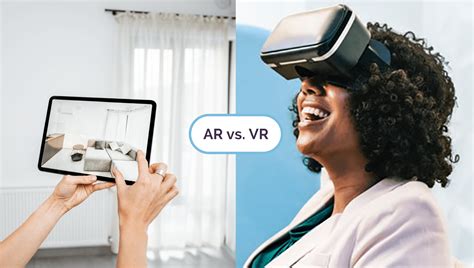Augmented Reality vs. Virtual Reality: Key Differences and Uses

This blog post explores the key differences between Augmented Reality (AR) and Virtual Reality (VR). Augmented Reality enhances the real world by overlaying digital information, as opposed to VR, which immerses users in completely digital environments. Understanding the basics of each technology is crucial before considering their applications. The piece highlights how AR subtly blends digital elements with our existing surroundings, while VR creates entirely new, simulated experiences. Finally, it offers guidance on choosing the right technology for specific needs and discusses future trends shaping both AR and VR.
Understanding The Basics: Augmented Reality And Virtual Reality
In today’s rapidly evolving technological landscape, Augmented Reality (AR) and Virtual Reality (VR) stand out as transformative forces, reshaping how we interact with the digital world. While both technologies offer immersive experiences, they differ significantly in their approach and application. AR enhances our perception of the real world by overlaying digital information onto it, whereas VR creates a completely simulated environment, disconnecting users from their physical surroundings. Understanding these fundamental differences is crucial for appreciating the unique potential of each technology.
AR technology works by using devices like smartphones, tablets, or specialized glasses to project computer-generated images, text, or other virtual elements onto the real world. This allows users to interact with both the physical and digital environments simultaneously. Think of applications like Pokémon GO, where virtual creatures appear in your real-world surroundings, or AR-enabled furniture apps that let you visualize how a new sofa would look in your living room. These experiences blend the digital and physical, enriching our everyday interactions.
Below is a detailed comparison table highlighting the key differences between AR and VR.
| Feature | Augmented Reality (AR) | Virtual Reality (VR) |
|---|---|---|
| Environment | Enhances the real-world environment | Creates a completely virtual environment |
| Immersion Level | Partially immersive; overlays digital content | Fully immersive; blocks out the real world |
| Hardware | Smartphones, tablets, AR glasses | VR headsets, motion trackers |
| Use Cases | Gaming, retail, education, navigation | Gaming, training simulations, entertainment |
Here are the main differences at a glance:
- Real vs. Simulated: AR enhances the real world; VR creates a simulated one.
- Immersion: AR offers partial immersion, while VR provides full immersion.
- Hardware Needs: AR often uses smartphones; VR requires headsets.
- Interaction: AR allows interaction with both real and virtual elements; VR focuses on virtual interaction.
- Applications: AR is used in navigation and retail; VR is common in gaming and simulations.
In contrast, VR technology utilizes headsets to create an entirely computer-generated world, isolating users from their physical environment. This allows for highly immersive experiences, such as exploring ancient ruins, flying through space, or participating in realistic training simulations. VR applications often require additional hardware like motion trackers and controllers to enhance the sense of presence and interaction within the virtual world. While VR demands more specialized equipment and a controlled environment, it offers unparalleled opportunities for escapism and realistic training scenarios. Both AR and VR technologies continue to evolve, promising even more innovative applications in the years to come.
Okay, I will create the content section according to your instructions, focusing on Augmented Reality and adhering to all the specified HTML tags, structure, and requirements. html
Augmented Reality: Enhancing The Real World With Digital Overlays
Augmented Reality (AR) is a technology that overlays digital information onto the real world, enhancing the user’s perception of their environment. Unlike Virtual Reality (VR), which creates a completely immersive digital world, AR supplements reality with computer-generated images, sounds, and other sensory enhancements. This blend of the physical and digital worlds offers a wide range of possibilities across various industries and applications, transforming how we interact with information and our surroundings.
How Augmented Reality Works
The functionality of AR hinges on several key components working in concert. These include sensors to capture environmental data, processors to interpret that data and generate the digital overlays, displays to present the augmented view, and software algorithms to accurately align the digital content with the real world. Tracking and recognition technologies are crucial for anchoring virtual objects to specific locations or objects in the real world, ensuring a stable and believable augmented experience.
Here is a comparison table of the different AR types:
| Type of AR | Description | Examples | Use Cases |
|---|---|---|---|
| Marker-Based AR | Uses specific visual markers (like QR codes) to trigger the overlay. | AR business cards, printed ads with AR enhancements | Marketing, education |
| Markerless AR | Uses environmental data (location, depth) to place overlays. | Pokemon Go, AR furniture apps | Gaming, retail, navigation |
| Projection-Based AR | Projects digital images onto physical surfaces. | AR sandboxes, interactive art installations | Education, entertainment |
| Overlay AR | Replaces a view of reality with an augmented one. | Medical visualizations, repair applications | Healthcare, manufacturing |
Examples Of Augmented Reality Applications
The applications of Augmented Reality are vast and ever-expanding. In retail, AR allows customers to virtually try on clothes or place furniture in their homes before making a purchase. In healthcare, AR assists surgeons by overlaying real-time patient data onto their field of vision during operations. The automotive industry uses AR for heads-up displays in vehicles, providing drivers with crucial information without distracting them from the road. Furthermore, AR is transforming education by creating interactive and engaging learning experiences. These are just a few examples of how AR is changing the way we live and work.
Below are the steps on how to experience AR:
- Choose an AR Application: Select an app that aligns with your interests, such as gaming, shopping, or education.
- Ensure Device Compatibility: Make sure your smartphone or tablet meets the app’s minimum requirements.
- Download and Install: Get the app from your device’s app store and install it.
- Grant Permissions: Allow the app access to your camera and other necessary features.
- Follow On-Screen Instructions: Most AR apps provide guidance on how to use their features.
- Point and Scan: Aim your device’s camera at the designated target (if required) or your environment.
- Interact and Explore: Engage with the digital overlays and explore the augmented experience.
Benefits Of Using Augmented Reality
The benefits of incorporating Augmented Reality are numerous. It enhances user engagement by creating interactive and immersive experiences, leading to increased customer satisfaction and brand loyalty. AR improves efficiency in various tasks, from training and maintenance to navigation and design. It also offers enhanced visualization, allowing users to see products or concepts in a realistic and practical context. Furthermore, AR provides valuable data and insights, enabling businesses to make informed decisions and optimize their operations. Overall, AR empowers users with new capabilities and drives innovation across industries.
An expert quote to emphasize the power of AR:
Augmented reality is going to change the way we use technology forever. – Tim Cook, Apple CEO
Virtual Reality: Immersing Users In Completely Digital Environments
Virtual Reality (VR) takes a different approach than Augmented Reality, creating a completely digital environment that users can immerse themselves in. Instead of overlaying digital information onto the real world, VR replaces it entirely, offering a simulated experience that can range from realistic simulations to fantastical, imagined worlds. This immersive quality is achieved through the use of headsets that block out the user’s physical surroundings and display stereoscopic images, creating a sense of depth and presence within the virtual world.
| Feature | Virtual Reality (VR) | Example |
|---|---|---|
| Environment | Completely digital, simulated world | Gaming environments, training simulations |
| User Interaction | Fully immersed and interactive within the digital world | Using controllers to manipulate objects, navigating virtual spaces |
| Technology | VR headsets, motion tracking, haptic feedback | Oculus Rift, HTC Vive, PlayStation VR |
| Use Cases | Gaming, training, education, therapy, entertainment | Flight simulators, surgical training, virtual tourism |
The applications of VR are incredibly diverse. In gaming, VR offers unparalleled levels of immersion, allowing players to step inside the game world and interact with it in a natural and intuitive way. Beyond entertainment, VR is also being used in training and simulation for high-risk professions, such as pilots, surgeons, and soldiers. These simulations provide a safe and controlled environment for trainees to practice critical skills and make decisions without real-world consequences.
- Gaming and entertainment
- Medical training and surgery simulations
- Military and defense simulations
- Architectural visualization and design
- Virtual tourism and travel experiences
- Education and historical recreations
Furthermore, VR is finding its way into education, allowing students to explore historical sites, dissect virtual organisms, and engage with abstract concepts in a more tangible and engaging way. The potential for VR to transform various industries and aspects of our lives is immense, offering new ways to learn, work, and connect with others. As technology continues to advance, we can expect even more innovative and transformative applications of VR to emerge, further blurring the lines between the physical and digital worlds.
Virtual reality was once the dream of science fiction. But the internet was also once the dream of science fiction. – Megan Smith
Choosing The Right Technology: Key Considerations And Future Trends
Selecting between Augmented Reality (AR) and Virtual Reality (VR) hinges on understanding your specific objectives and the experiences you aim to create. Both technologies offer unique capabilities, but their applications and the user experience they deliver are fundamentally different. AR enhances the real world by overlaying digital information, while VR creates entirely new, immersive digital environments. Therefore, carefully assessing the context, target audience, and desired outcomes is crucial for making an informed decision.
| Feature | Augmented Reality (AR) | Virtual Reality (VR) |
|---|---|---|
| Environment | Enhances the real world | Creates a completely digital world |
| User Interaction | Interacts with digital elements in a real-world setting | Interacts within a simulated environment |
| Hardware | Smartphones, tablets, AR glasses | VR headsets, controllers |
| Applications | Gaming, retail, education, training | Gaming, entertainment, training, simulations |
Cost is another significant factor. AR applications often have lower development and deployment costs since they can leverage existing mobile devices. VR, on the other hand, typically requires specialized hardware and more complex development processes, leading to higher overall expenses. Consider the long-term scalability and maintenance costs associated with each technology to ensure your investment aligns with your budget and strategic goals.
- Actionable Steps For Implementation
- Clearly define your objectives and desired outcomes.
- Assess your target audience and their needs.
- Evaluate the development and deployment costs.
- Consider the user experience and accessibility.
- Plan for long-term scalability and maintenance.
Looking ahead, both AR and VR are poised for significant growth and innovation. Advancements in hardware, software, and connectivity will continue to drive new applications and improve user experiences. Keep an eye on emerging trends such as the metaverse, spatial computing, and the integration of AI, as these will undoubtedly shape the future of AR and VR. By staying informed and adaptable, you can leverage these technologies to create compelling and transformative experiences.
Ultimately, the right technology depends on your specific needs and vision. By carefully evaluating these key considerations and keeping abreast of future trends, you can make an informed decision that delivers the greatest value and impact. Whether you choose to enhance reality with AR or create entirely new worlds with VR, the possibilities are vast and ever-expanding.



